What family does radish belong to, its characteristics and description
After a long winter, the body needs double the amount of vitamins. In early spring, radishes become the main supplier of beneficial compounds. What a radish is, what a radish looks like and what color it is, why this plant is not useful for everyone - you will find out in our article.
What is the correct name: radish or radish?
In conversation you can often hear: “I have radishes in my garden...” However, the scientific name of this vegetable crop is “radish.” However, both names are correct.
In the first case, the everyday name is used, in the second - the official name of the cultivated plant. Variants of names are used depending on the situation. In this article we will stick to the second option.
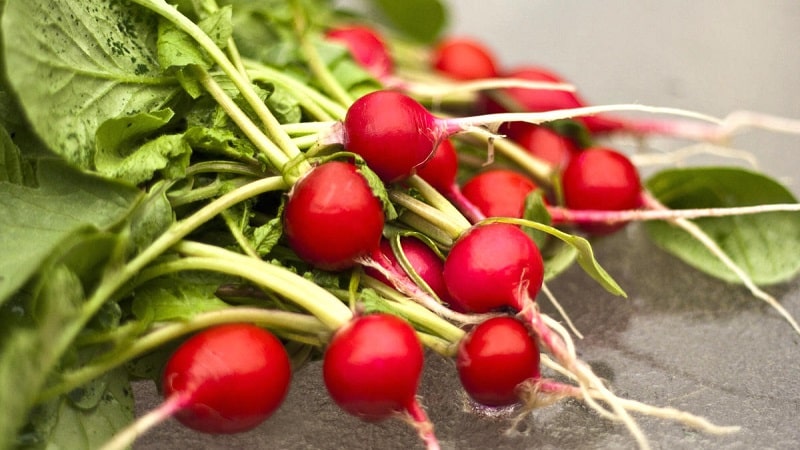
Description and characteristics of culture
The word "radish" is borrowed from the Latin "radix", literally translated - "root". It turns out that all root vegetables can be safely called “radish”.
What family does radish belong to?
Radish (radish sativum) belongs to the Brassicaceae or Cruciferous family and belongs to the cultivated radish genus. Radishes and radishes are similar to each other not only in appearance, but also for its beneficial properties.
Are radishes a vegetable, a fruit, or something else?
Radish is a root vegetable, so it is customary to call it a vegetable., not a fruit, although some varieties taste sweet. Depending on the variety, radishes live for a year, less often – two.
Origin story
The exact place of origin of radishes has not yet been determined. It is generally accepted that his homeland is Asia.. There are references to this vegetable in the ancient chronicles of Egypt, Greece, Japan, China and Rome. The culture was brought to Europe in the 16th century, and the plant appeared in Russia under Peter I.
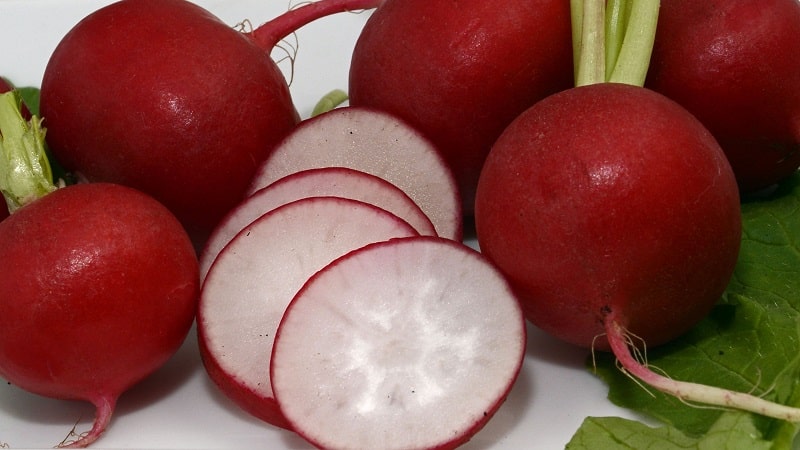
Chemical composition, trace elements and vitamins, beneficial properties
The roots and tops contain vitamins A, C, D, E, PP, group B, phosphorus, sodium, iron, copper, calcium and iodine.
Assimilated in the body, radishes accelerate metabolic processes, restore strength after illness, and relieve pain.. Pain in the back, joints, pinched sciatic nerve, stress, nervous strain - all these conditions can be cured by the pink and white root vegetable.
The vegetable helps eliminate toxins and bile, strengthens blood vessels. Suitable for dietary nutrition, since 100 g of product contains only 20 kcal.
Radishes are used in cosmetology. It has a beneficial effect on the condition of hair, skin, and complexion. It is used in natural face masks.
Here is the recipe for one of them:
- Grate 5 large root vegetables and squeeze out the juice through cheesecloth.
- Mix 1 tsp. natural coffee with 1 tsp. crushed fresh chamomile.
- Pour radish juice over the coffee and chamomile mixture and stir.
- Apply the paste to the skin of the face and leave for 15 minutes, rinse with warm water.
This procedure softens and cleanses the skin, tightens pores, and activates collagen synthesis. and elastin, prevents rashes and eliminates sagging skin.
Attention! Radishes contain no less ascorbic acid than oranges. If you are allergic to citrus fruits, replace oranges with radishes. It will protect the body from colds and infections.
Ripening period
Radishes are the leader among vegetable crops in terms of ripening time. From the moment the first shoots appear on the surface of the earth until full maturation, it takes from 18 to 60 days.Early varieties are harvested within three weeks.
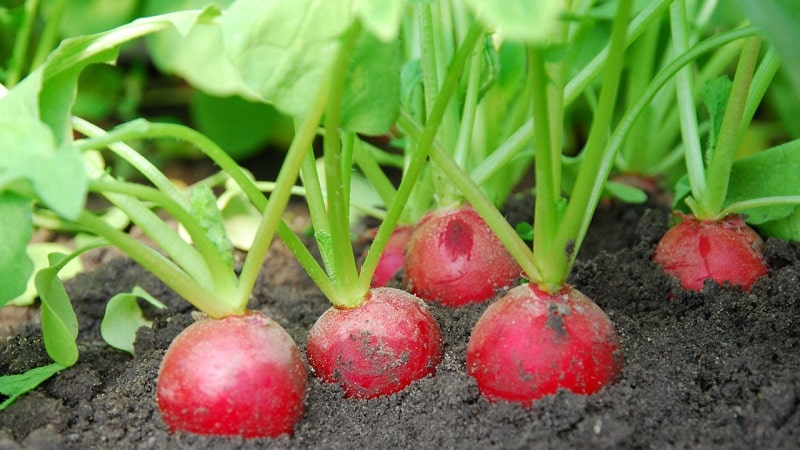
Productivity
Radish yield depends on care, variety and place of growth. In a greenhouse, 3.5-4 kg of vegetables are harvested per 1 m². In open ground with proper care, the average is 3 kg per 1 m².
Disease resistance
Due to its rapid ripening, radishes are rarely affected by diseases.. When grown in unfavorable conditions, vegetables can become infected with white rust, powdery mildew, black leg and gray rot.
Characteristics of fruits, description of appearance, taste
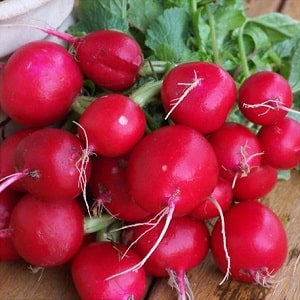 The tops are up to 25 cm high, the leaves have a noticeable edge of hard hairs. Foliage color ranges from light green to dark green. The radish root goes to a considerable depth in the soil. The type of radish fruit is a dry pod with a spout of different lengths.
The tops are up to 25 cm high, the leaves have a noticeable edge of hard hairs. Foliage color ranges from light green to dark green. The radish root goes to a considerable depth in the soil. The type of radish fruit is a dry pod with a spout of different lengths.
The root vegetable is juicy, sweetishly pungent, ranging in size from 1.5 to 10 cm in diameter. The mustard oil content gives many varieties of radish a slight pungency, but there are also varieties in which bitterness is completely absent. Root vegetables come in different shapes: round, round-flat, conical, oval, spindle-shaped and cylindrical. Weight varies from 10 to 150 g.
The inside of the root is white, pink or white-pink depending on the variety. The outside color also depends on the variety. Root vegetables grow red, pink, white, yellow, green or even purple with white tails.
For which regions is it best suited and what are the climate requirements?
Radishes can be grow in almost any region of Russia, it is approved for cultivation in the Central, North-Western, Middle Volga, North Caucasus and West Siberian regions.
Feels great at air temperatures from 18 to 25°C.
The main advantages and disadvantages of radishes
Despite all the advantages of radish, its vitamin complex useful not for all.
Let us examine in more detail the advantages of culture and its disadvantages.
Advantages:
- a storehouse of vitamins and nutrients;
- low calorie;
- rich in fiber;
- has a beneficial effect on the skin, promotes wound healing and relieves pain;
- increases hemoglobin levels;
- improves blood circulation;
- reduces swelling;
- increases immunity;
- stabilizes metabolic processes.
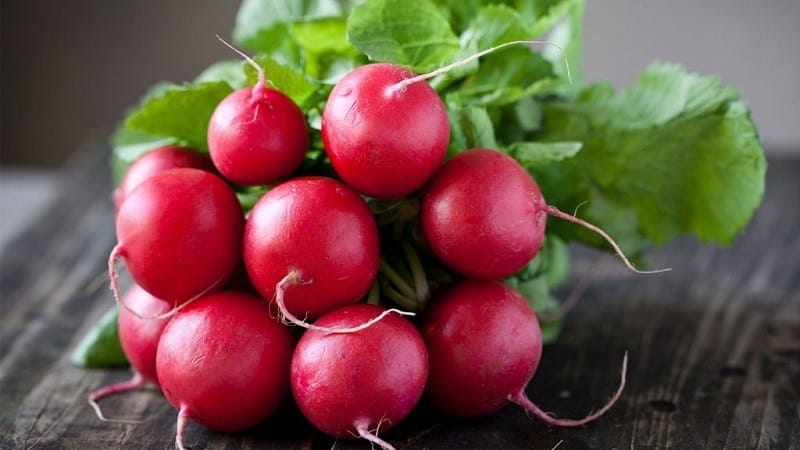
Flaws:
- It is not recommended to drink on an empty stomach - concentrated juice causes irritation of the stomach walls, which provokes pain;
- the rich composition of radishes can cause significant harm to the body of people suffering from diseases of the stomach, intestines, liver and biliary tract;
- It is forbidden to eat large quantities of radishes during inflammatory processes of the thyroid gland;
- undesirable for pregnant and breastfeeding women, as it causes bloating and colic in babies;
- Radishes can affect heart rate, so they are not recommended for those who have had a heart attack.
Radish tops even healthier than the root vegetable itself, since it contains all valuable nutrients in concentrated form.
Take note:
Preparing radishes for the winter by freezing and other methods
The best pickled radish recipes for the winter
Simple and delicious recipes for healthy radish snacks
Radish varieties
Radish represented by a large number of different varieties and hybrids. Initially, the root vegetable looked more like a short carrot, and only modern selection made the shape of the vegetable round or oval.
Early varieties and hybrids:
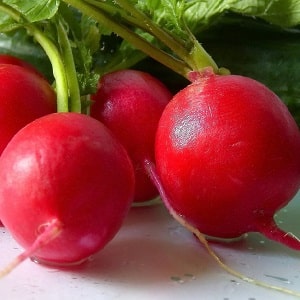 Presto (on the picture). A high-yielding, universal variety, suitable for cultivation in most regions of Russia.Bred in 2002, it has good germination and is resistant to frost and temperature changes. Root vegetables do not crack. Harvesting is carried out on days 16-20 after the first shoots, 2.5-3 kg per 1 m², the weight of each vegetable is up to 11 g.
Presto (on the picture). A high-yielding, universal variety, suitable for cultivation in most regions of Russia.Bred in 2002, it has good germination and is resistant to frost and temperature changes. Root vegetables do not crack. Harvesting is carried out on days 16-20 after the first shoots, 2.5-3 kg per 1 m², the weight of each vegetable is up to 11 g.- Cherriet. Japanese hybrid, cultivated in Russia since 2007. Suitable for greenhouses and open ground. Resistant to shooting. The root crop is round in shape, rich red in color, the flesh is white, moderately spicy, weighing up to 40 g. Productivity up to 3 kg per 1 m². Increased resistance to fusarium, clubroot, and blackleg.
- French breakfast. Can be harvested 25-27 days after germination. It has an elongated cylindrical shape, dark pink color, with a white tail, fruit length 7-15 cm, weight 30-40 g, white flesh, without bitterness. Tolerates cold well. Productivity from 2.5 to 3.5 kg per 1 m².
- Heat. Brought out in the USSR more than 60 years ago. It is distinguished by its ease of care and high yield, up to 3.5-4 kg per 1 m². The growing season is 18-25 days. The root vegetable is round, red, weighing 13-30 g, the flesh is white, sweetish, moderately spicy, crispy. Does not form voids and is not prone to bolting. Suitable for winter sowing.
- 16 days. Exactly 16 days are enough for the full ripening of this variety of radish. It develops equally well in a greenhouse and in open ground. The roots are round, bright red, the flesh is juicy and white. The taste is delicate, medium-hot. The variety is resistant to bolting and cracking.
- Champion. Weight 17-20 g, rich red color, round shape, thin peel, white pulp, medium bitter. Suitable for growing in greenhouses and open ground, as well as at home. Productivity is average, up to 1.5 kg per 1 m². Ripening period – 25 days. Well kept.
Mid-season varieties:
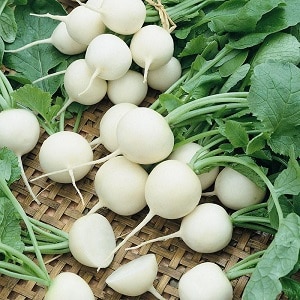 Polar bear, or Virovsky white (photo on the right). Round radish is white, weighs about 25 g, ripens in 30 days, yield is within 2 kg per 1 m². Suitable for cultivation in the northern regions of the country. Open ground is recommended. The variety is highly resistant to flowering and has good shelf life. The taste is medium spicy, sweet.
Polar bear, or Virovsky white (photo on the right). Round radish is white, weighs about 25 g, ripens in 30 days, yield is within 2 kg per 1 m². Suitable for cultivation in the northern regions of the country. Open ground is recommended. The variety is highly resistant to flowering and has good shelf life. The taste is medium spicy, sweet.- Duro. The desired size is reached in 28-30 days. The variety is large, spherical in shape, weight up to 40 g, scarlet in color, the flesh is mostly white, spicy-sweet. About 3.5 kg of radishes are harvested from 1 m². It can be stored for a month without losing its appearance or taste.
- Zlata. Czech variety, tolerates moderate drought well. It is fully formed on days 30-32. The shape is round, the color is yellow, the flesh is white with a pungent taste. Weight up to 25 g, yield – 2 kg per 1 m².
- Rebel. Hybrid. Suitable for open ground and greenhouses. Harvesting occurs 28-30 days after germination, 2.5 kg of product per 1 m². Root vegetables with thin bright red skin, round shape, weighing 17-20 g. Disease-resistant, shelf life about 4 months.
Late varieties:
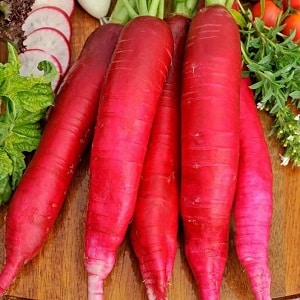 Red giant (pictured right). Planted in open and protected ground. The pink root vegetable has an elongated, cylindrical shape, up to 15 cm long and weighing 100-150 g. The pulp is dense, without voids, the taste is piquant, slightly spicy. The variety is cold-resistant, high-yielding. You will need to wait 40-50 days before harvesting; 4.5 kg of radish can be grown per 1 m². Demanding on lighting and humidity.
Red giant (pictured right). Planted in open and protected ground. The pink root vegetable has an elongated, cylindrical shape, up to 15 cm long and weighing 100-150 g. The pulp is dense, without voids, the taste is piquant, slightly spicy. The variety is cold-resistant, high-yielding. You will need to wait 40-50 days before harvesting; 4.5 kg of radish can be grown per 1 m². Demanding on lighting and humidity.- Ice icicle. It resembles an icicle in shape and color. A white, long vegetable with juicy, pungent pulp, weighing about 100 g. The variety is high-yielding and can be grown well in greenhouses and open ground. No more than 45 days pass from germination to harvesting. Resistant to shooting.
- Dungansky 12/8. The growing method is universal. White-pink radish with a sweet-sharp taste, weighing about 75 g. Ripeness occurs in 35-50 days, depending on the region of growth, you can harvest up to 3.5 kg per 1 m2.
Rare varieties and hybrids:
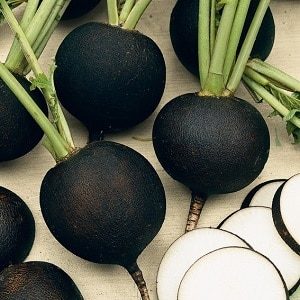 Black Spanish (on the picture). Radishes ripen in 53-70 days and look more like turnips. It has a black peel and snow-white, hot, crispy flesh. This radish variety is known for its valuable nutritional properties, ease of cultivation and long shelf life. It does not tolerate heat well, needs shade and coolness, otherwise it will quickly crack.
Black Spanish (on the picture). Radishes ripen in 53-70 days and look more like turnips. It has a black peel and snow-white, hot, crispy flesh. This radish variety is known for its valuable nutritional properties, ease of cultivation and long shelf life. It does not tolerate heat well, needs shade and coolness, otherwise it will quickly crack.- Watermelon radish. An unusual hybrid of radish and radish was bred in China. It quickly became popular due to its appearance: a light green spherical vegetable with bright raspberry flesh. Bitter on the outside and sweet on the inside, weighing up to 200 g. This root vegetable is cold-resistant, can withstand light frosts, ripens in a month and produces up to 10 kg of radish per 1 m². The main disadvantage is short storage, no more than 10 days.
What difficulties may there be when growing
There should be no difficulties when growing radishes.. The culture is unpretentious, but loves care, especially watering. Even a novice gardener can cope with it.
Take care of the soil for the vegetable in the fall, fertilize the selected area: half a bucket of humus or compost per 1 m² will be enough. If you don’t want the radishes to become hollow inside, do not fertilize the ground with fresh manure - use decomposed manure or dilute fresh with water in equal quantities.
Advice from experienced gardeners
Take the advice of experienced gardeners, and growing a rich harvest of radishes, similar to the advertising photos on the seed packaging, will not be difficult:
- early varieties of radish form a root crop quite quickly and stop growing - do not expect a large mass from them, this is not genetically determined;
- do not overexpose ripe radishes in the beds, the vegetable will become “woody”, hollow, and unsuitable for consumption;
- if you grow root crops in open ground, then the temperature should be high not only during the day, but also at night - not lower than 10°C;
- The ripening period of a vegetable is affected by the size of the seeds - when sowing, choose the largest ones, then the radish will grow faster.
Conclusion
A tasty and healthy vegetable relieves pain, strengthens the immune system, diversifies the menu and pleases the eye with an abundance of colors and shapes. But those who have chronic gastrointestinal health problems should not overuse radishes; first consult with your doctor.